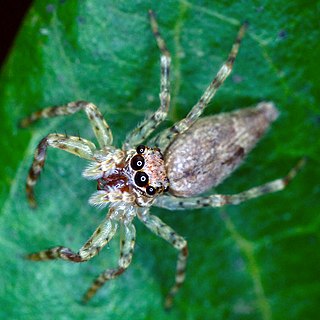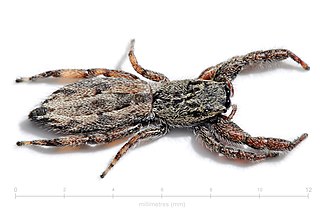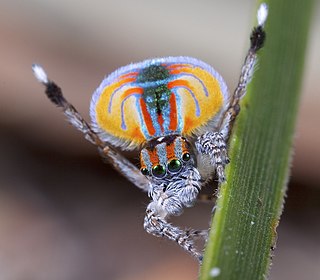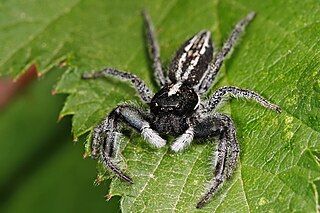
Cosmophasis is a genus of spiders in the family Salticidae. Some species occur in Africa, while most are found in Southeast Asia, down to Australia. Although most species more or less mimic ants, there are also colorful species that follow a different strategy.

Helpis is a genus of the spider family Salticidae.

Holoplatys is a genus of the spider family Salticidae.
Ligonipes is a spider genus of the jumping spider family, Salticidae. Five of the six described species are found in the Australian region, the exception being Ligonipes similis, recorded as being from Sumatra. Their body form mimics ants.

Maratus is a spider genus of the family Salticidae. These spiders are commonly referred to as peacock spiders due to the males' colorful and usually iridescent patterns on the upper surface of the abdomen often enhanced with lateral flaps or bristles, which they display during courtship. Females lack these bright colors, being cryptic in appearance. In at least one species, Maratus vespertilio, the expansion of the flaps also occurs during ritualised contests between males. The male display and courtship dance are complex, involving visual and vibratory signals.

Margaromma is a spider genus of the jumping spider family, Salticidae. The eight described species occur mostly in Australia and New Zealand, with several other species on Pacific islands. One species is found in Cameroon.

Ocrisiona is a genus of jumping spiders that was first described by Eugène Louis Simon in 1901. O. frenata from Hong Kong belongs to a different, unspecified genus, according to Marek Żabka (1990). Eugene Simon places the genus Ocrisiona close to Holoplatys.

Opisthoncus is a genus of South Pacific jumping spiders that was first described by Ludwig Carl Christian Koch in 1880. There are still many Australian species that have not yet been described.
Paraphilaeus is a genus of the jumping spiders found in Queensland and New South Wales. It contains only one species, Paraphilaeus daemeli. Though it has been known for a long time, in 2003, closer investigation showed that it represents a new genus and is neither related to Plexippus nor Trite. The genus name is derived from Ancient Greek para "alongside" and the salticid genus Philaeus.
Paraplatoides is a genus of South Pacific jumping spiders that was first described by Marek Michał Żabka in 1992.

Sandalodes is a genus of jumping spiders that was first described by Eugen von Keyserling in 1883. S. scopifer, a black spider with white markings, is a common species in eucalypt forests on the Darling Downs.

Servaea is a genus of jumping spiders that was first described by Eugène Louis Simon in 1888. S. murina females are about 8 millimetres (0.31 in) long.

Simaetha is a genus of Australasian jumping spiders that was first described by Tamerlan Thorell in 1881. They resemble members of Simaethula and Stertinius.
Tauala is a genus of jumping spiders that was first described by F. R. Wanless in 1988. The name "Tauala" is an arbitrary combination of letters.

Zenodorus is a genus of the jumping spiders distributed from the Moluccas to Australia, including several islands of the Pacific. It was once considered a junior synonym of Omoedus, but this was later rejected by Jerzy Prószyński in 2017. At least one species, Z. orbiculatus, specializes on hunting ants.

Prostheclina pallida is a species of spider in the family Salticidae, native to Eastern Australia. It was described by Keyserling in 1882, and remained the only species in the genus until 2007, when six more species were described.

Euophryini is a tribe of jumping spiders. It has also been treated as the subfamily Euophryinae.

Plebs is a genus of orb-weaver spiders first described by M. M. Joseph & V. W. Framenau in 2012. Though many of its species have been moved around, a 2012 taxonomic revision suggested that these spiders comprise a monophyletic genus of closely related spiders that evolved in Australia and, through subsequent movements, spread into parts of Asia and Pacific islands.
Deliochus is a genus of South Pacific orb-weaver spiders first described by Eugène Simon in 1895.














